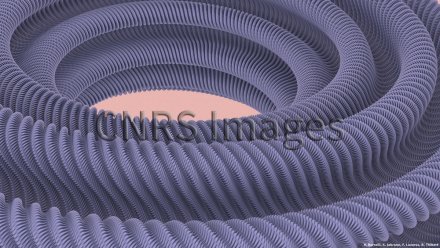Production year
2012

© Vincent BORRELLI/Saïd JABRANE/Francis LAZARUS/Boris THIBERT/CNRS Images
20120001_0718
Vue externe du plongement isométrique d'un tore carré plat, en 3D, dans l'espace ambiant. Les différentes vagues d'ondulations sont appelées corrugations. Leur accumulation créé un objet ressemblant à une fractale et ayant un aspect rugueux. Il s'agit d'une fractale lisse, à mi-chemin entre les fractales et les surfaces ordinaires. Pour cette représentation, les chercheurs se sont basés sur la théorie de l'intégration convexe et ils ont utilisé la technique de corrugations (oscillations). Ces résultats ouvrent notamment des perspectives pour la visualisation des solutions des équations différentielles rencontrées en physique ou en biologie. Les propriétés des fractales lisses pourraient également jouer un rôle central dans l'analyse de la géométrie des formes.
The use of media visible on the CNRS Images Platform can be granted on request. Any reproduction or representation is forbidden without prior authorization from CNRS Images (except for resources under Creative Commons license).
No modification of an image may be made without the prior consent of CNRS Images.
No use of an image for advertising purposes or distribution to a third party may be made without the prior agreement of CNRS Images.
For more information, please consult our general conditions
2012
Our work is guided by the way scientists question the world around them and we translate their research into images to help people to understand the world better and to awaken their curiosity and wonderment.